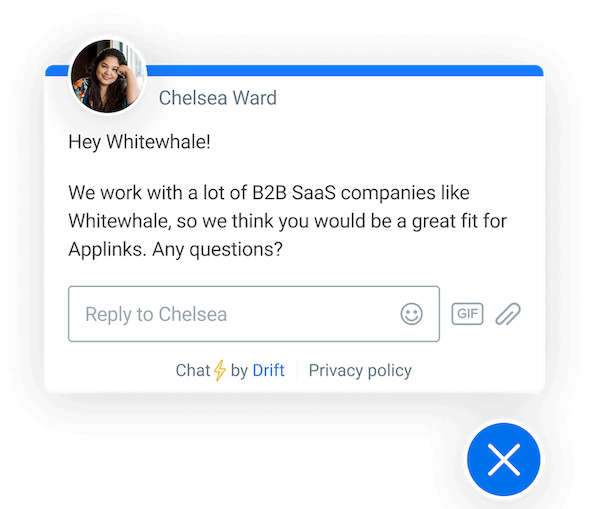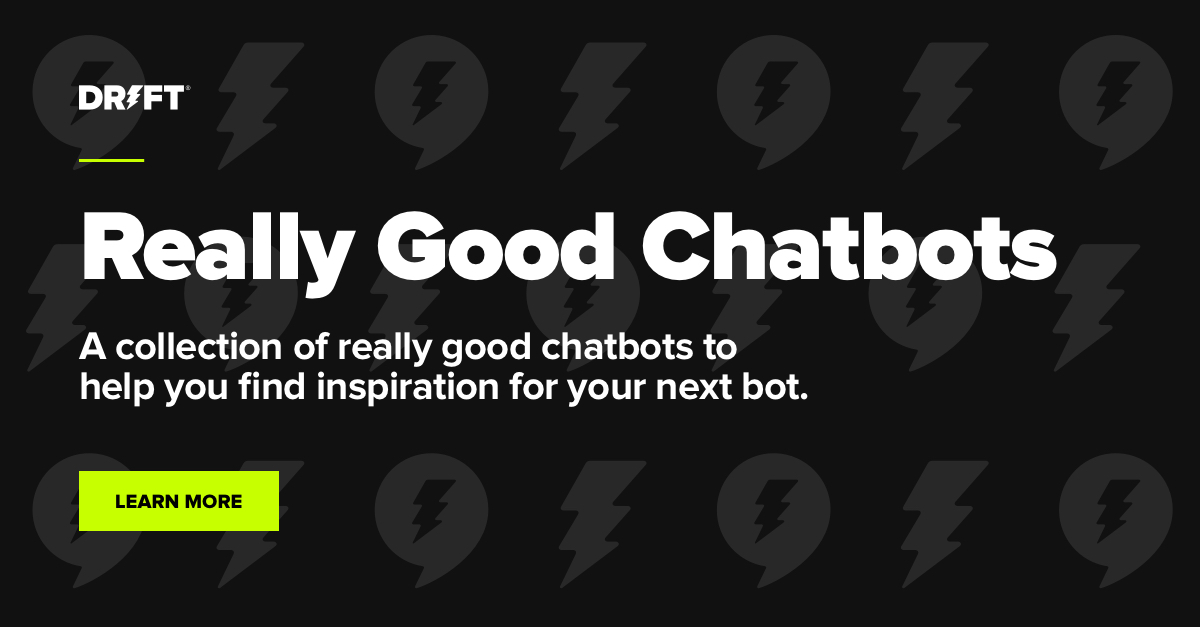It’s no secret that we love chatbots.
And if you asked us to pick our favorites, we’d have a hard time doing it. Because, here at Drift, there are countless chatbots that have helped us and our customers spark conversations with buyers every single day.
But today, we’re doing the impossible and sharing the best of the best chatbots — our Hall of Famers. The ones who are nailing the conversation game and have the results to prove it.
But before we dive into our picks, let’s quickly review what a chatbot is and what makes a chatbot really good 🤖
What Is a Chatbot?
Chatbots are software applications that simulate human conversation. Most chatbots follow a set of pre-existing rules to respond to buyers and answer their questions. Some chatbots also use machine learning and natural language processing (NLP) to leverage conversational data so they can improve their conversations with buyers without human input.
A chatbot’s main objective is to remove friction from the buying process through quick and relevant interactions. Depending on the type of business, this could mean delivering a piece of content, answering a technical question, or connecting buyers to a sales rep if they’re ready to buy.
So, let’s say we’re a customer interested in buying some software from Applinks. We’ve already done some research and compared a few vendors. Since this is our fourth visit to their website, instead of a generic welcoming message, we get something like this:

Like in this example, chatbots help build a service that is centered around the customer, allowing them to explore their needs and interests on their time and on their terms.
With chatbots at the forefront of your customer-centric experience, you not only make your customer’s day but also ensure that your company stands out from the competition, every time.
How Chatbots Use Conversational Marketing
When it comes to personalization, we like to really dig in.
Drift’s chatbots use Conversational Marketing to deliver a chat experience that is unique to each buyer type. So depending on where your buyer is in the buying journey (and a variety of other factors like who they are or what web page they are on), a very specific chat playbook is triggered.
Every great chatbot follows the same formula when talking with a potential buyer. We call it the Conversational Marketing Framework, and there are three steps to it: engage, understand, and recommend.
Here’s a breakdown of each step 👇
Engage: Ask & Acknowledge
This first step is where you engage with visitors through personalized and relevant messaging, allowing them to start a conversation with you instantly. Whether you want to offer assistance to someone browsing your pricing page or check in on repeat visitors, you can proactively engage the people who are most serious about buying.
Understand: Learn & Respond
This step is where you build relationships with your buyers, learning about their goals and challenges. Though this involves asking the usual qualifying questions, it all happens through natural conversation. And, by the end, you’ll know who is ready for a sales conversation so you can make sure your sales reps are spending time with people who are genuinely interested in buying.
Recommend: Guide & Suggest
Once you’ve engaged your buyer and understood their needs, it’s time to close the sale. In this step, you can use intelligent routing to automatically connect qualified buyers to your sales team or book meetings if they’re not available. And for those who aren’t ready to buy, you can deliver relevant content and work on nurturing them to the next stage.
Our Favorite Chatbot Examples
Welcome to the gallery of champions. Here, you’ll find all the chatbots that are using Conversational Marketing to have conversations that wipe out the competition.
To give you a sense of where these chatbots are being used in the buyer journey, we’ve categorized them by the three stages of the Conversational Marketing Blueprint. Let’s dive in ⚡️
Stage 1: Engage Website Visitors
Gong: Engage All
Engage
Gong engages the website visitor with a cheeky hook that draws the site visitor in.
Understand
Once engaged, the bot asks the site visitor a few follow-up questions to see why they are on the site and how the bot can best guide them in the right direction, as well as understand if Gong is the right fit for them.
Recommend
Site visitors who are a good fit for Gong are recommended to chat with sales or book a meeting. Those who aren’t ready or need more information on Gong are guided toward best practice content.
Okta: Return Visitor (AI)
Engage
This AI playbook engages the site visitor by recognizing they are returning to the site and uses that context to add humor stating, “Things must be getting serious!”
Understand
This bot does a great job of understanding the return visitor’s goals, offering three different journeys with varying intent. Additionally, the Conversational AI allows the site visitor to type in anything they are interested in, and the AI responds accordingly.
Recommend
This bot (with the help of AI) recommends both chatting live or scheduling a meeting for those interested in speaking with sales and provides backup CTAs for those not yet ready.
Stage 2: Target Potential Buyers
Lessonly: Paid Ad Converter
Engage
This bot hook acknowledges that the buyer has come to the site via an ad and offers to give them more information.
Understand
The bot goes on to understand how they’d like to learn more. For those ready for a meeting, the bot qualifies the site visitor. This bot has a great qualifying path — asking only a few questions and keeping it conversational.
Recommend
Finally, the bot drops a calendar for qualified site visitors. For those who may not be a great fit for Lessonly, the bot shares the typical contract price and shares a video with more information. If they are still interested, the bot drops a calendar.
ConnectWise: Event Bot
Engage
The bot provides information on what the conference is about and when it’s happening while still gauging interest.
Understand
The bot understands that the visitor is trying to learn about a specific event, and that could mean anything from agenda to tickets to registration.
Recommend
The bot recommends all possible actions to someone seeking out more information about the event and allows them to buy tickets.
Okta: Product Qualified Lead
Engage
This bot engages the site visitor by hitting on a pain point they may be feeling and offering to help answer questions about the free trial.
Understand
The bot goes on to better understand the site visitor by asking what type of support they need.
Recommend
The bot then recommends support, a conversation with sales, or relevant content based on what the site visitor is interested in.
Stage 3: Accelerate Deal Cycles
Drift: Solution Bot
Engage
This AI solution bot engages the site visitor by offering an interactive way to test out the solution.
Understand
The bot uses AI to understand what the site visitor is looking for. Once it answers their question, it continues to guide buyers with buttons and allows them to type in a question.
Recommend
The bot recommends a chat with our team. It also acknowledges not everyone is ready for a sales conversation — for those site visitors, the bot recommends relevant content.
Okta: Website Concierge (AI)
Engage
This AI website concierge bot greets first-time visitors to the site and engages them.
Understand
Using AI, the site visitor is able to type in any questions they may have and the bot understands the request and responds accordingly. The bot continues the conversation, understanding what pain point the site visitor is trying to solve.
Recommend
After understanding the pain point this first-time site visitor is trying to solve, the bot recommends appropriate content and offers to connect them with sales.









